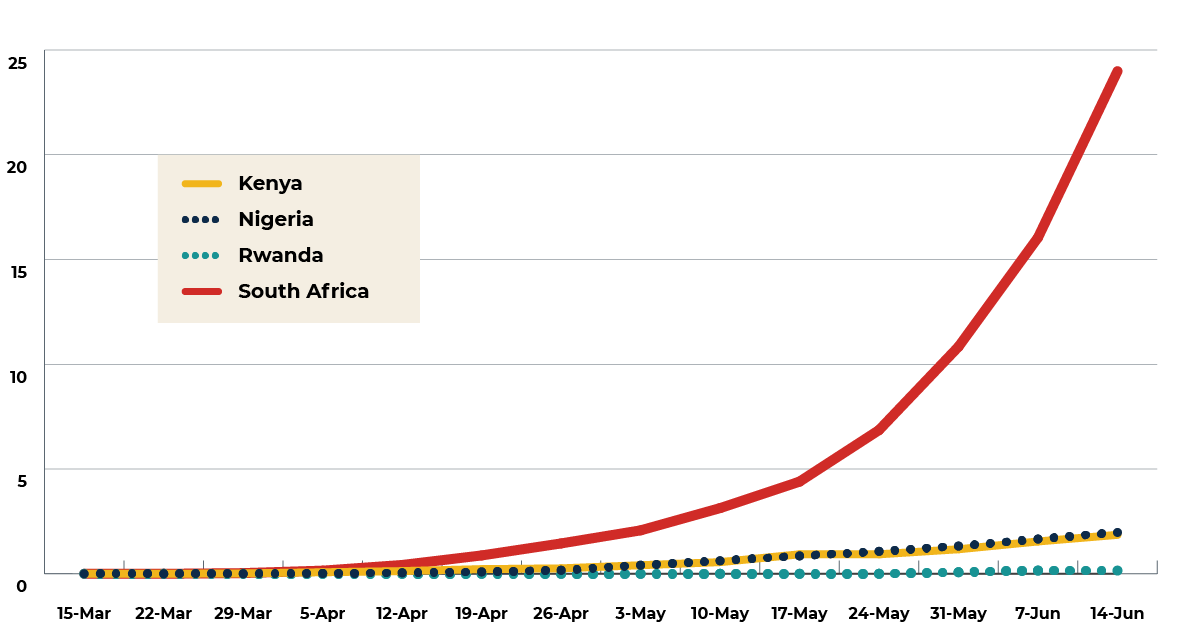This blog is part of our Growing the Evidence series, which contains evidence and insights uncovered by Mathematica’s researchers in the international food and agriculture sector.
The prevalence of COVID-19 in Africa has been lower than in other continents, but the steps taken to prevent the spread of the disease are affecting African economies and the pandemic is expected to result in sharp economic downturns. By June 15, 2020, the number of deaths per million in Africa was very low compared with other regions. South Africa reported the highest rate at 25 deaths per million, according to the European Center for Disease Prevention and Control, with more than 80,000 cases to date. Uganda reported zero deaths related to COVID-19 and 732 confirmed cases. The number of deaths per million by June 15 was 0.2 in Rwanda, 1.9 in Kenya, and 2 in Nigeria. In contrast, the United States had reported 359 deaths per million by June 15.
COVID-19 deaths per million

In African countries, efforts to prevent infection have been swift and strict. Despite having no or very few known cases, Uganda and neighboring Rwanda had some of Africa’s strictest lockdown measures, including shuttering all but essential businesses, instituting dusk-to-dawn curfews, and banning private and public transport vehicles in March. By early April, the South African and Kenyan governments enforced a complete lockdown, and the Nigerian government closed down three major states, including the capital Abuja, restricting the movement of people and closing all nonessential business. Nigeria, Africa’s most populous nation, closed its land borders and, like many other African countries, banned all international flights in late March.
Unsurprisingly, COVID-19 is affecting African economies both because of global disruptions outside leaders’ control and because of the lockdowns most countries have imposed. The steep drop-off in tourism, reduced demand for exports, and cessation of imports caused by disruptions in the global supply chain comprise external shocks. Lockdowns are also creating significant contraction in domestic economic activity. The combined impact of domestic and global disruptions is likely to slow growth through 2021. Kenya’s growth forecast has dropped from 5.7 percent to 1 percent, and Uganda’s has decreased from 5.3 percent to 3.5 percent. And the South African and Nigerian economies are expected to contract by 5.8 percent and 3.4 percent, respectively, in 2021.
That’s the big picture, but what has this meant for families? To answer this question over time as the pandemic progresses, FinMark Trust worked with GeoPoll to field high-frequency surveys in Kenya, Nigeria, Rwanda, South Africa, and Uganda. The surveys began in late April and were administered repeatedly over two-week periods, covering a range of household outcomes such as food security and income. Using an innovative approach to weight the telephone-based surveys, Mathematica was able to uncover insights from an early round of these surveys by creating nationally representative estimates.
The data presented here spans late April to early June and begins to show how the pandemic was affecting these countries and how households were responding. Taking a deeper look at the initial data revealed especially interesting insights regarding access to services and mobility restrictions, coping mechanisms families are using, and early impacts on food security and income.
Access to services
Many households across all five countries faced travel restrictions and reported limited access to their finances. Their ability to send and receive money, however, was not diminished in this early stage of the pandemic. Except for Rwanda, households reported higher costs for medicines, although they could still find medicine in the market.
Travel restrictions and households’ access to services (late April to early May)
|
Scroll right to view
all countries
No medicine
Medicine costs more
No access to finances
No send/receive money
|

Kenya |

Nigeria |

South Africa |

Rwanda |

Uganda |

Zambia |

Ghana |
Coping mechanisms
In response to virus mitigation efforts, most households in all five countries reported using masks and hand sanitizer and said that they sought medical care if they had COVID-19-like symptoms. The majority of the households reported that they did not travel in the previous two weeks (close to 80 percent across all countries). A lower proportion stayed at home (closer to 40 percent), and a somewhat smaller proportion avoided groups. In Nigeria for example, about 20 percent of the households reported avoiding large groups. In response to the adversities posed by COVID-19, some households reported the need to borrow money or miss loan repayments. However, across all countries, fewer than 20 percent of households reported undertaking these measures.
Household social-distancing response and coping strategies
|
Scroll right to view
all countries
Seek med care if sympts
More hand sanitizer
Wear face mask
Avoid big groups
Stay at home
No travel last 14 days
Missed repaying loan
Borrowed recently
|

Kenya |

Nigeria |

South Africa |

Rwanda |

Uganda |

Zambia |

Ghana |
Food security and income impacts
Unsurprisingly, households reported earning lower income compared with their income before the pandemic. They also reported having reduced availability of food and eating fewer meals for more than two days of the week.
Income and food security impacts of COVID
|
Scroll right to view
all countries
Reduced income
Less food availability
Not eat > 2 meals/week
|

Kenya |

Nigeria |

South Africa |

Rwanda |

Uganda |

Zambia |

Ghana |
We analyzed these outcomes across rural and urban households but found that results were largely similar. As we analyze additional rounds of data from these surveys, we will examine how these outcomes change over time and if the households’ conditions change in terms of access to services, their coping mechanisms, and their income and food security outcomes. Understanding the effects of the pandemic and resulting economic downturns will help us understand households’ resilience and aid policymakers in efforts to help households in Africa regain their incomes and normal levels of food consumption.
Watch this space for updated analyses based on the latest versions of these data sets, including new data from Zambia and Ghana!
The data used in this blog is derived from the COVID-19 tracker phone survey that FinMark Trust is undertaking with GeoPoll in seven countries across sub-Saharan Africa. Mathematica provides analytical support to the project by cleaning and weighting the raw survey data to create nationally representative estimates; we then apply multilevel regression with post-stratification to enable analysis for subgroups of interest, such as women and rural populations. The survey includes about 75 questions and is administered every two weeks in each country, starting in April 2020.
Seek med care if sympts
More hand sanitizer
Wear face mask
Avoid big groups
Stay at home
No travel last 14 days
Missed repaying loan
Borrowed recently
No medicine
Medicine costs more
No access to finances
No send/receive money
Reduced income
Less food availability
Not eat > 2 meals/week
|

Kenya |

Nigeria |

South Africa |

Rwanda |

Uganda |

Zambia |

Ghana |




